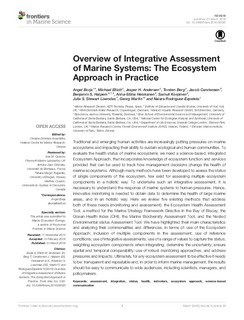Overview of Integrative Assessment of Marine Systems: The Ecosystem Approach in Practice
Borja, Angel; Elliott, Michael; Andersen, Jesper H; Berg, Torsten; Carstensen, Jacob; Halpern, Benjamin S.; Heiskanen, Anna-Stiina; Korpinen, Samuli; Lowndes, Julia S. Stewart; Martin, Georg; Rodríguez-Ezpeleta, Naiara
Journal article, Peer reviewed
Published version
Permanent lenke
http://hdl.handle.net/11250/2507263Utgivelsesdato
2016Metadata
Vis full innførselSamlinger
- Publikasjoner fra Cristin - NIVA [2160]
- Scientific publications [1172]
Sammendrag
Traditional and emerging human activities are increasingly putting pressures on marine ecosystems and impacting their ability to sustain ecological and human communities. To evaluate the health status of marine ecosystems we need a science-based, integrated Ecosystem Approach, that incorporates knowledge of ecosystem function and services provided that can be used to track how management decisions change the health of marine ecosystems. Although many methods have been developed to assess the status of single components of the ecosystem, few exist for assessing multiple ecosystem components in a holistic way. To undertake such an integrative assessment, it is necessary to understand the response of marine systems to human pressures. Hence, innovative monitoring is needed to obtain data to determine the health of large marine areas, and in an holistic way. Here we review five existing methods that address both of these needs(monitoring and assessment): the Ecosystem Health Assessment Tool; a method for the Marine Strategy Framework Directive in the Bay of Biscay; the Ocean Health Index (OHI); the Marine Biodiversity Assessment Tool, and the Nested Environmental status Assessment Tool. We have highlighted their main characteristics and analyzing their commonalities and differences, in terms of: use of the Ecosystem Approach; inclusion of multiple components in the assessment; use of reference conditions; use of integrative assessments; use of arange of values to capture the status; weighting ecosystem components when integrating; determine the uncertainty; ensure spatial and temporal comparability; use of robust monitoring approaches, and address pressures and impacts. Ultimately, for any ecosystem assessment to be effective it needs to be: transparent and repeatable and, in order to inform marine management, the results should be easy to communicate to wide audiences, including scientists, managers, and policy makers.

